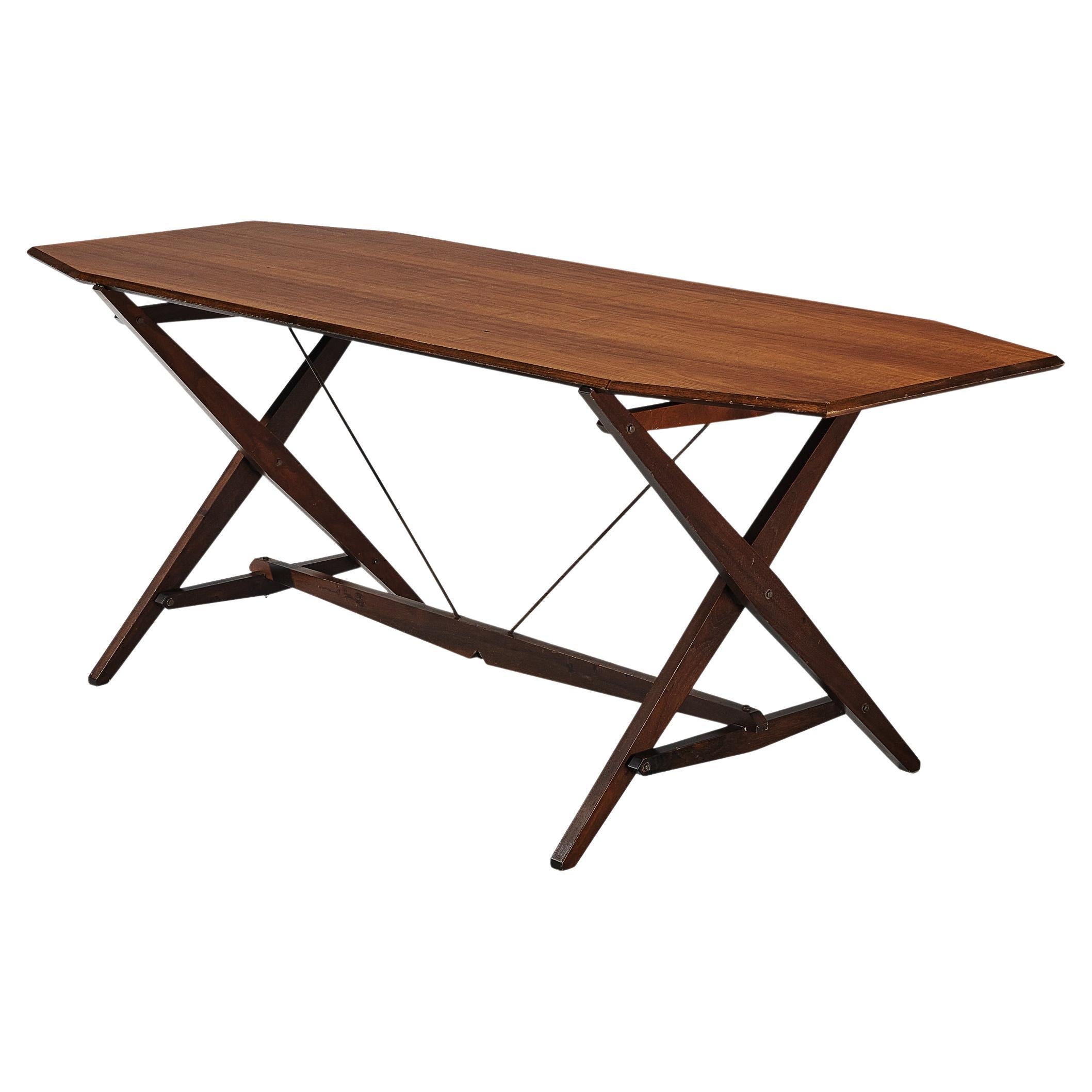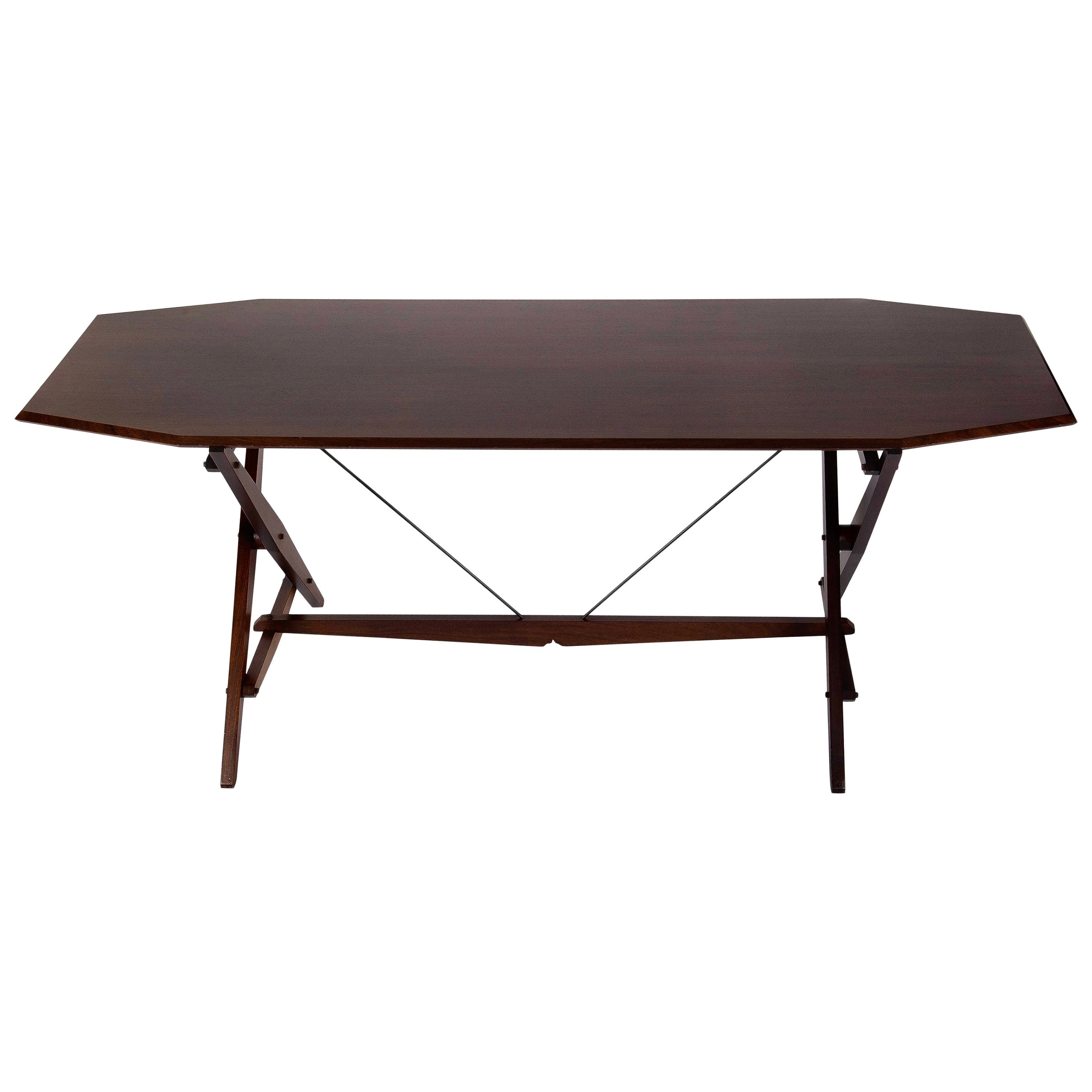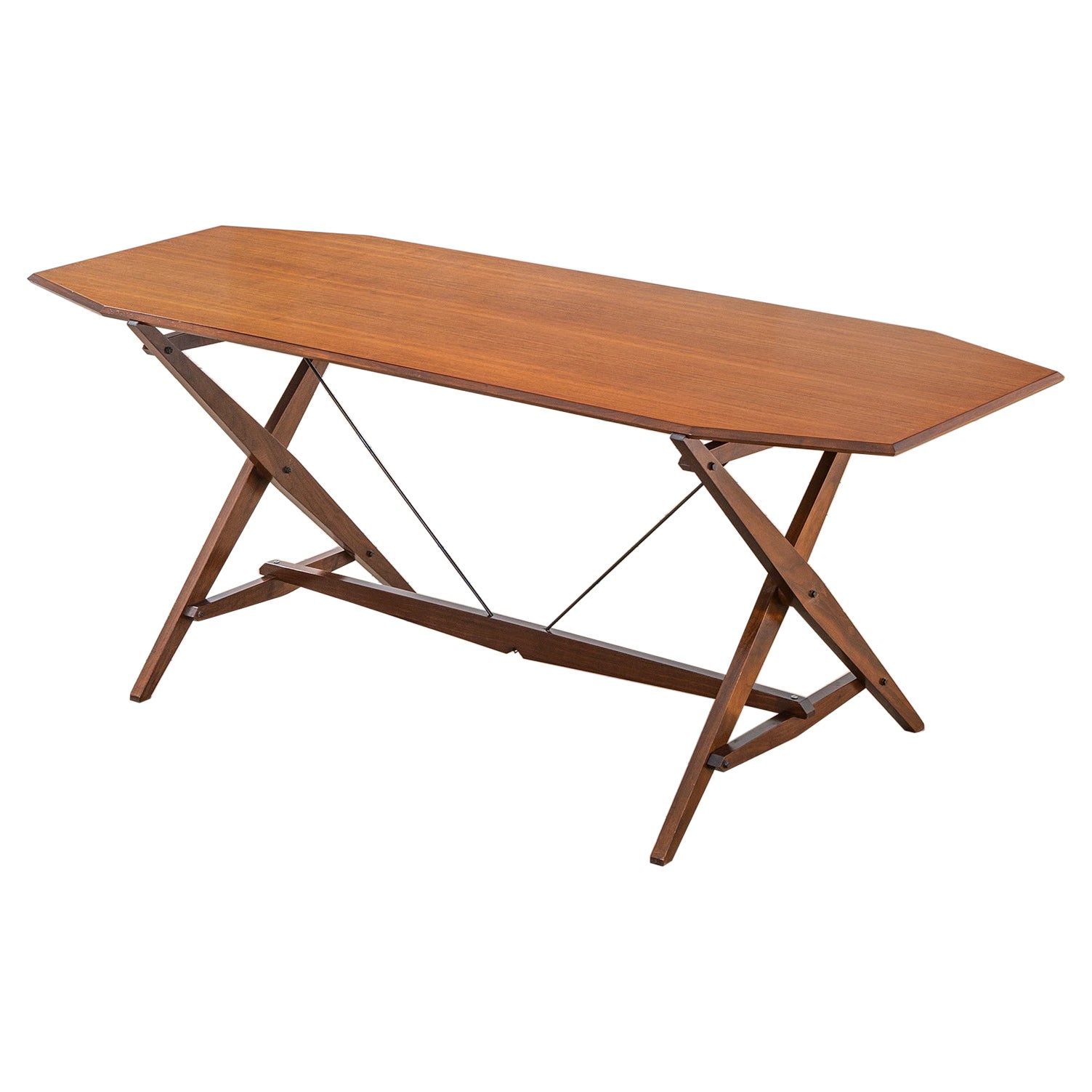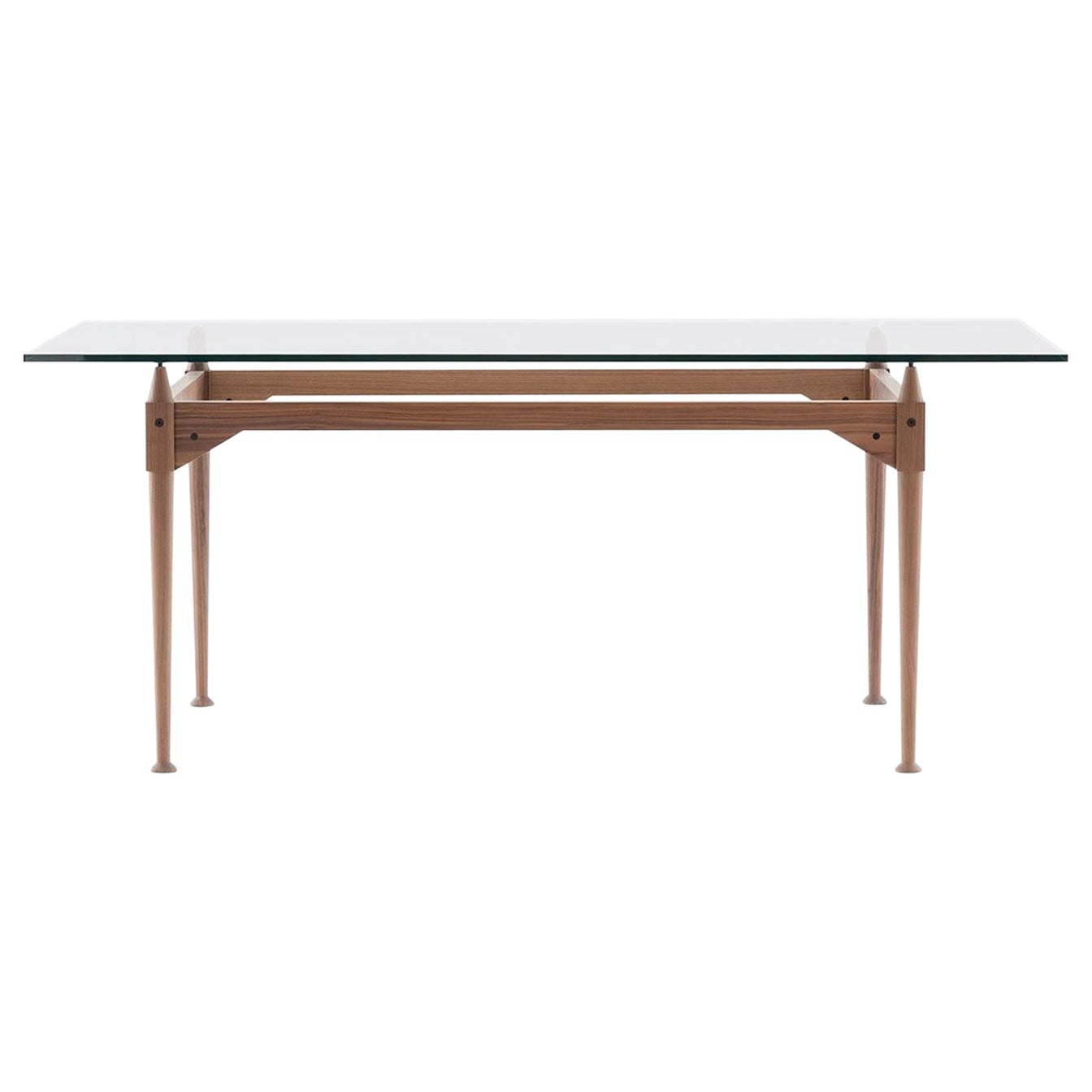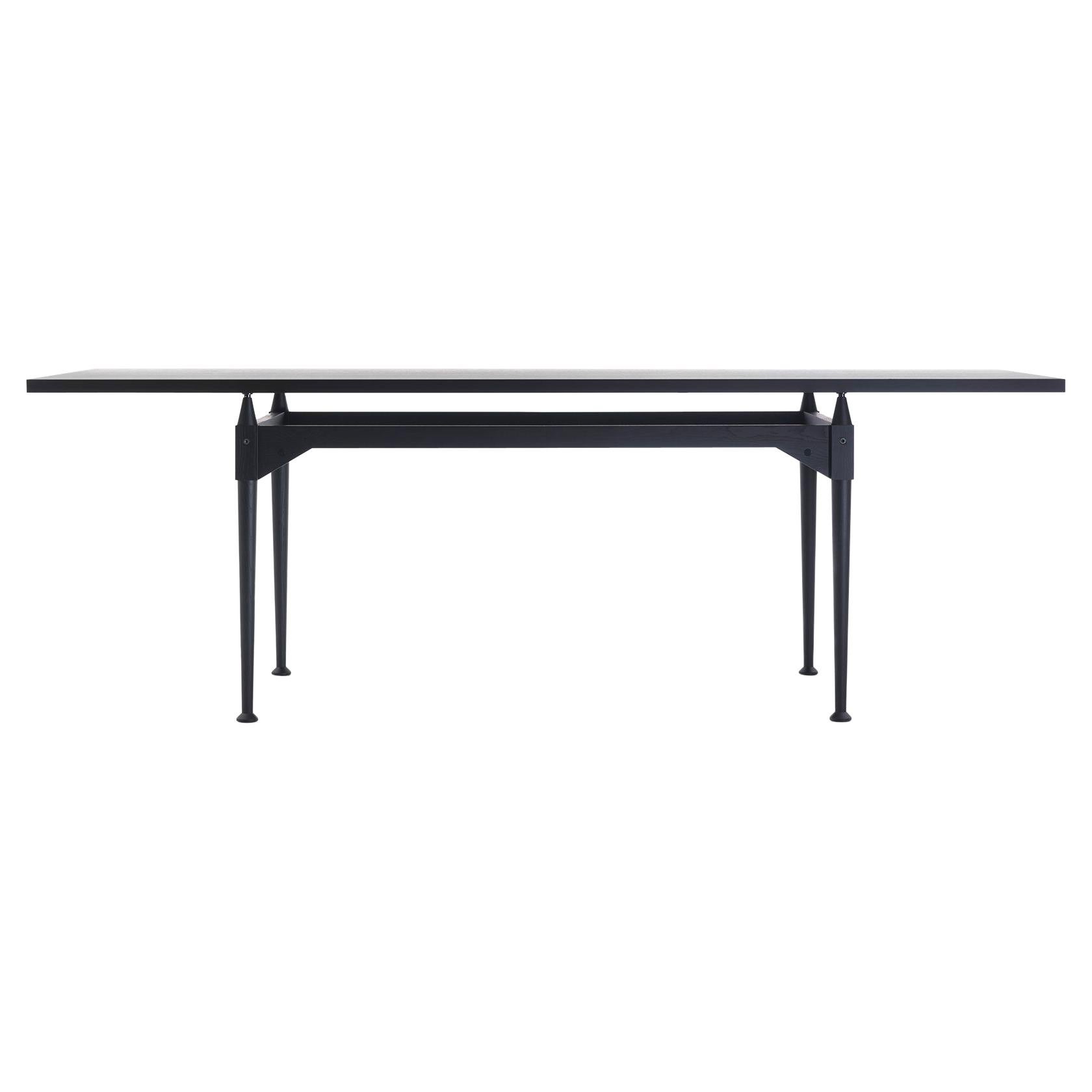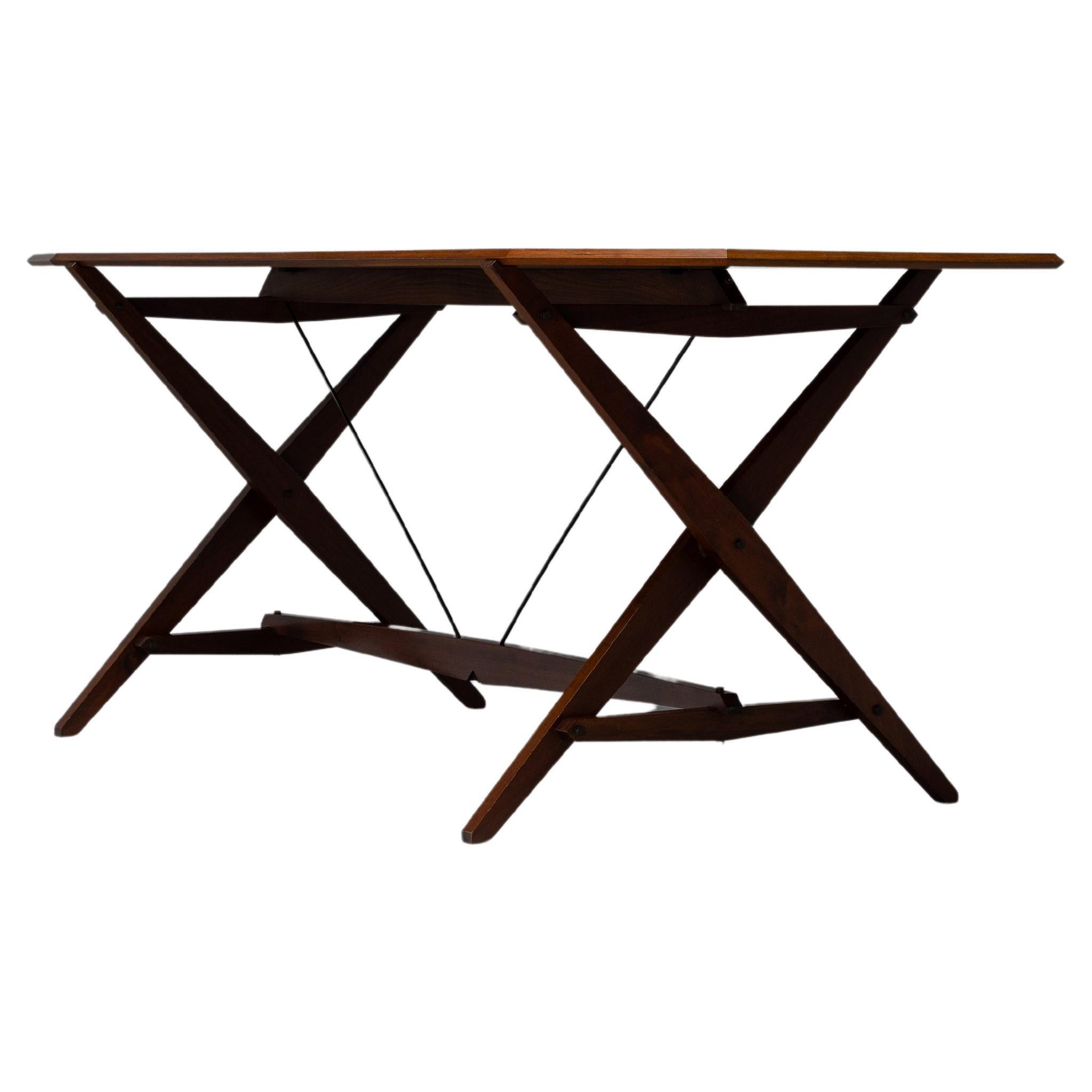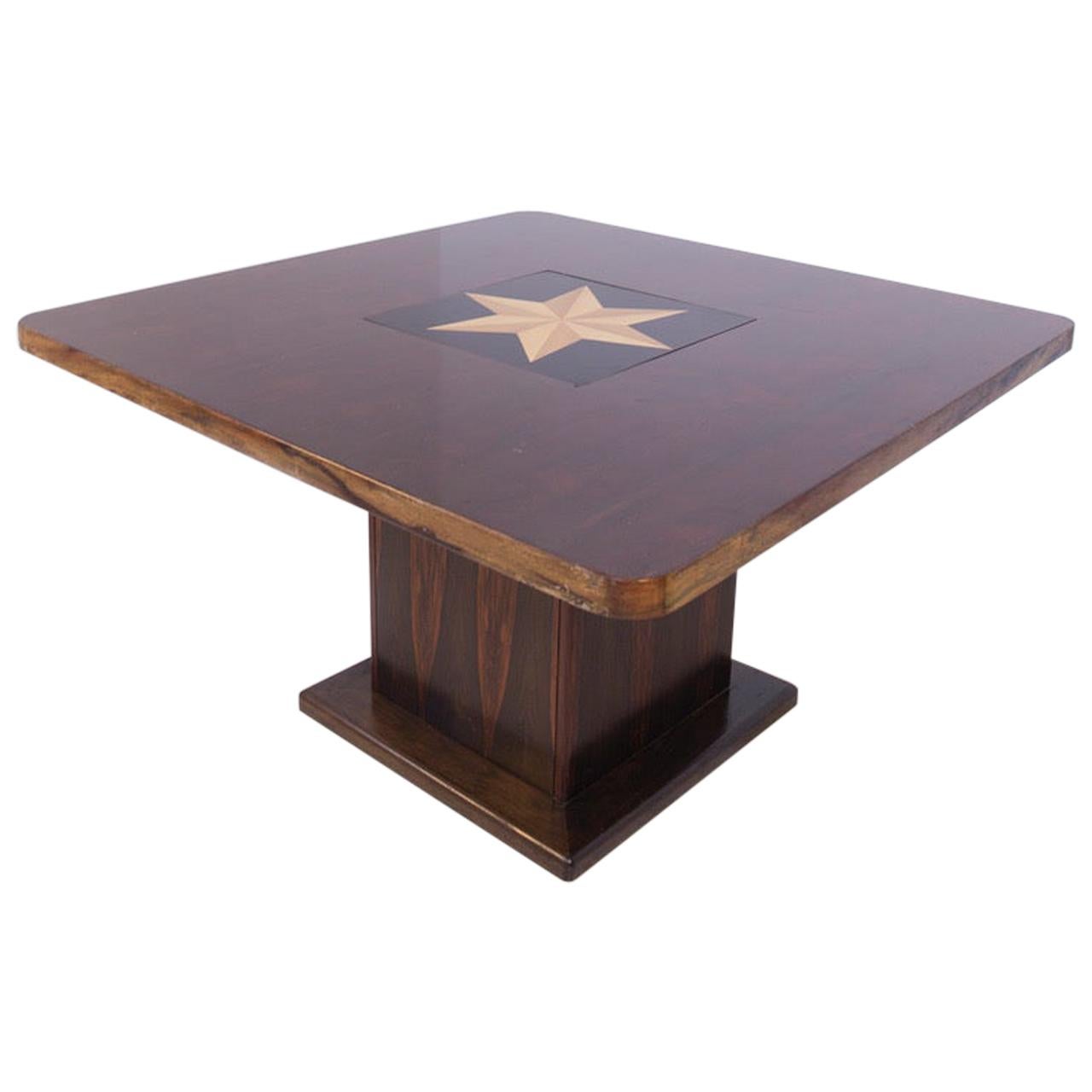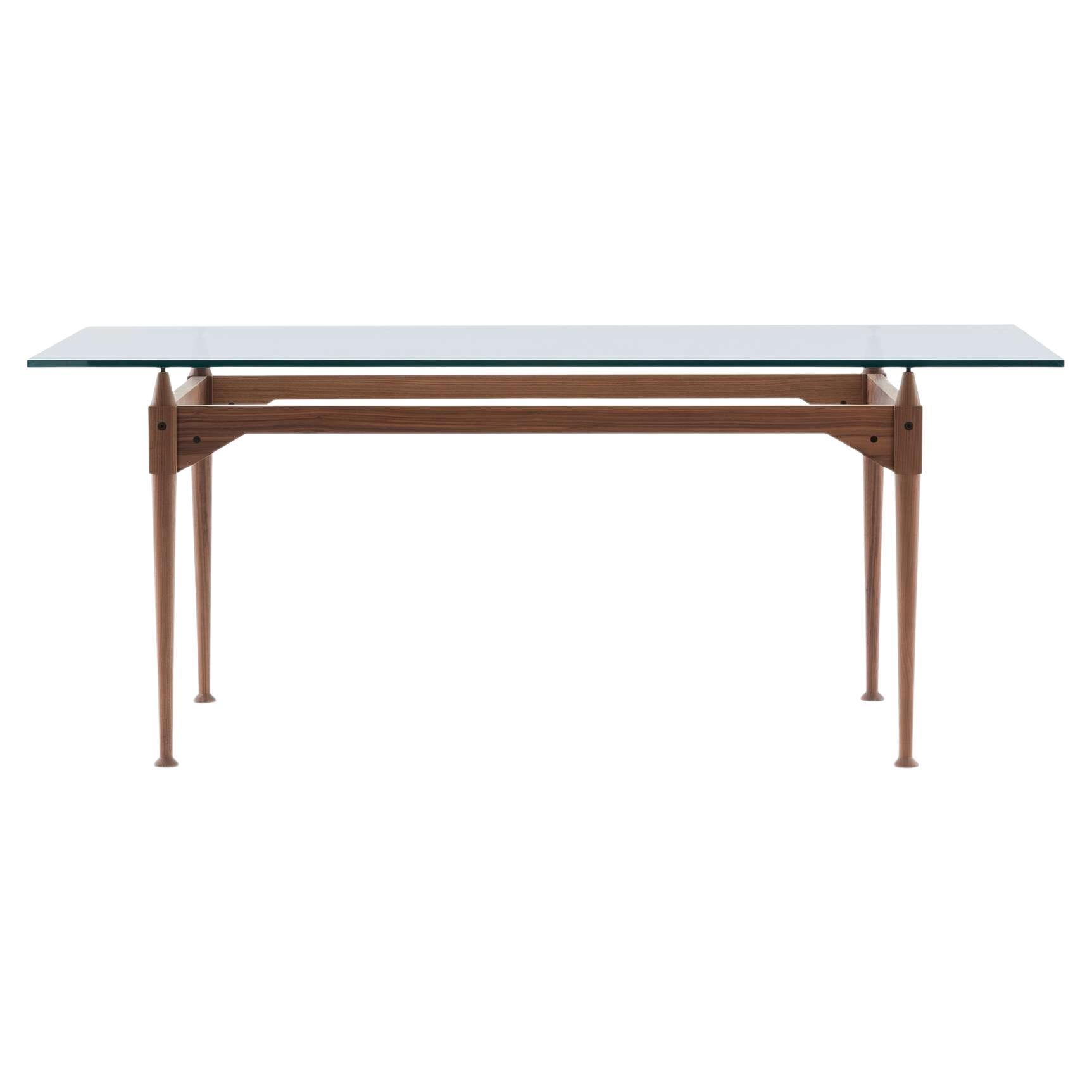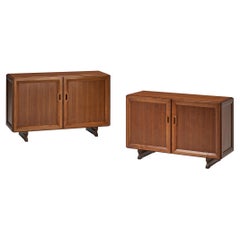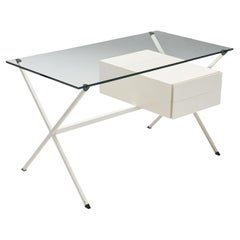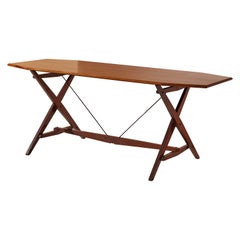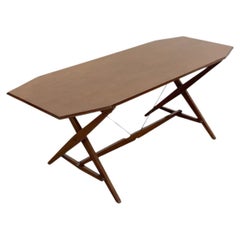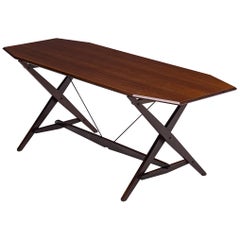
Franco Albini 'TL2' Table in Walnut
View Similar Items
Franco Albini 'TL2' Table in Walnut
About the Item
- Creator:Franco Albini (Designer),Poggi (Manufacturer)
- Dimensions:Height: 27.96 in (71 cm)Width: 70.87 in (180 cm)Depth: 27.56 in (70 cm)
- Style:Mid-Century Modern (Of the Period)
- Materials and Techniques:Metal,Walnut
- Place of Origin:Italy
- Period:1950-1959
- Date of Manufacture:1951
- Condition:Refinished. Wear consistent with age and use. Surface shows minor scratches in the top, which can be solved in our in-house atelier.
- Seller Location:Waalwijk, NL
- Reference Number:Seller: 450123541stDibs: LU933116523332
Franco Albini
While working under the polymath Gio Ponti — arguably the most important figure in 20th-century Italian modernism — furniture designer Franco Albini nurtured a love for modern forms combined with traditional craft techniques.
Albini is widely known for working with organic materials such as rattan and cane for his chairs and other seating, but he also played a pivotal role in the Italian rationalist movement of the early 20th century, which saw architects and furniture makers applying a strict emphasis on geometry in their work. Rationalists drew on Ancient Roman architecture but rejected ornament, much in the way that Le Corbusier and celebrated Bauhaus figures such as Ludwig Mies van der Rohe had in their modernist furniture.
Albini received his degree in architecture from the Polytechnic University of Milan in 1929, and, in 1931, he founded his practice in Milan, where he tackled workers’ housing and other reconstruction projects. A gifted urban planner, he also developed the Palazzo Bianco, Palazzo Rosso and Tesoro di San Lorenzo museums in Genoa. While Albini is revered for his Margherita chair — a Triennale Milano award winner created for Bonacina in 1951 — he also collaborated with manufacturers Poggi and Cassina in the 1940s on seating, tables and more that embodied his artistic vision. Of that mid-century work, the one piece that perhaps best captures this vision is the iconic Luisa chair.
With its cherry red upholstery and sinuous wooden legs that seem to float aboveground, the Luisa is a genuine masterpiece. It is also a testament to Albini’s perfectionism, as it endured several prototypes — including one made by Knoll in the late 1940s — and took approximately 15 years to design. Poggi launched the final version of the armchair in 1955, earning Albini the prestigious Compasso d’Oro from Italy’s Association for Industrial Design. It is produced today by Cassina. Albini named the chair for someone who likely saw the process firsthand: his personal secretary of two decades, Luisa Colombini.
Find vintage Franco Albini furniture on 1stDibs.

Established in 2006, Morentz has a team of approximately 55 restorers, upholsterers, interior advisers and art historians, making it a gallery, workshop and upholstery studio, all in one. Every day, a carefully selected array of 20th-century furniture arrives from all over the world at the firm’s warehouse, where the team thoroughly examines each piece to determine what, if any, work needs to be done. Whether that means new upholstery or a complete restoration, Morentz's aim is always to honor the designer’s intention while fulfilling the wishes of the client. The team is up to any challenge, from restoring a single piece to its original glory to furnishing a large-scale hotel project.
- Franco Albini for Poggi Dining Table in WalnutBy Franco Albini, PoggiLocated in Waalwijk, NLFranco Albini for Poggi, dining table, model TL2, walnut and iron, Italy, 1951. The TL2 table by Franco Albini features a simplistic and sleek design. Executed in darkened walnut wo...Category
Vintage 1950s Italian Mid-Century Modern Dining Room Tables
MaterialsIron
- Franco Albini for Poggi Cabinets in TeakBy Franco Albini, PoggiLocated in Waalwijk, NLFranco Albini for Poggi, cabinets, model MB51, teak, Italy, circa 1957. Well-designed pair of cabinets by Franco Albini for Poggi, which features a simplistic design with sharp lin...Category
Vintage 1950s Italian Mid-Century Modern Cabinets
MaterialsTeak
$5,500 / item - Early Franco Albini for Knoll Model '80' DeskBy Knoll, Franco AlbiniLocated in Waalwijk, NLFranco Albini for Knoll, model 80, glass, lacquered wood, lacquered steel, Italy, 1949 Franco Albini’s model 80 desk combines glass, steel and wood which resu...Category
1990s Italian Mid-Century Modern Desks and Writing Tables
MaterialsChrome
- Italian Art Deco Table in WalnutLocated in Waalwijk, NLDining table, walnut, nickel-plated brass, Italy, 1940s. This magnificent Italian Art Deco dining table exudes a commanding presence with its robust and daring design. The thick re...Category
Vintage 1940s Italian Art Deco Dining Room Tables
MaterialsBrass, Nickel
- Large Franco Albini for Poggi 'MB15' Sideboard in TeakBy Franco Albini, PoggiLocated in Waalwijk, NLFranco Albini for Poggi, sideboard model MB 15, teak, Italy, design 1957 Well-designed sizable sideboard by Franco Albini for Poggi in the 1950s in Italy. This design features a sim...Category
Vintage 1950s Italian Mid-Century Modern Sideboards
MaterialsTeak
- Large Florence Knoll Boat Shaped Conference Table in Walnut with Metal FrameBy Knoll, Florence KnollLocated in Waalwijk, NLFlorence Knoll for Florence Knoll International, large dining table, walnut, metal, United States, 1963. Large dining or conference table with boat shaped top in walnut. The table has six cylindrical metal legs. The top of this table shows the beautiful grain of the luxurious walnut. Nicely contrast of the natural and elegant top with modern and clean base. Due to its tapered shape, everyone at the table will be able to look each other in the eye. A perfect table for any dinner or meeting. Florence Knoll (1917) was trained as an architect and had a sense of style from a very young age. During her school time at Cranbrook, Eliel Saarinen (then the headmaster) and his family included her in their family. In 1936 she met Alvar Aalto and was trained by Marcel Breuer, Walter Gropius and (as if the long list of eminent designers is not long enough) Mies van der Rohe. This meant that although she was barely out of her teens, she was educated by the best of the European modernists. When she arrived in New York she worked on interior projects (being the only female) which is how she came to know Hans Knoll. When Florence joined Knoll, the planning unit started. Florence also made sure that the designs where more 'American Modernist' instead of Scandinavian, When Hans Knoll died she...Category
Vintage 1970s American Mid-Century Modern Dining Room Tables
MaterialsMetal
- Franco Albini teak dining Table Model TL2 'Cavalletto' for Poggi, Italy 1950sBy Franco Albini, PoggiLocated in Chiavari, LiguriaA dining table or desk Model TL2 by Franco Albini, better known as "Cavalletto", is an iconic piece designed by the esteemed Italian maestro in the 1950s. This table embodies the ess...Category
Vintage 1950s Italian Mid-Century Modern Dining Room Tables
MaterialsBrass
- Model Tl2 Desk / Dining Table by Franco Albini for Poggi, Italy, 1951By Franco Albini, PoggiLocated in Skokie, ILFranco Albini model TL2 desk or dining table for Poggi, Italy, 1950s Franco Albini for Poggi, dining table model TL2, walnut and metal, Italy, 1951. The TL2 table by Franco Alb...Category
20th Century Italian Mid-Century Modern Dining Room Tables
MaterialsPalisander
- Rare Mahogany 'TL2' Cavalletto Table / Desk by Franco Albini for Poggi, ItalyBy Franco Albini, PoggiLocated in London, GBA rare mahogany version of the Cavaletto or TL2 table designed by the great neo-rationalist designer, Franco Albini. Designed in 1950 for manufacturers Poggi...Category
Vintage 1950s Italian Mid-Century Modern Desks and Writing Tables
MaterialsSteel
- 20th Century Franco Albini Table Model TL2 "Cavalletto" in Wood for Poggi 1950sBy Franco Albini, PoggiLocated in Turin, TurinIconic table designed by the great Italian maestro Franco Albini in the 50s. The model is TL2 better known as "Cavalletto" (in english "Trestle") since it reminds of lightness and wi...Category
Vintage 1950s Italian Mid-Century Modern Dining Room Tables
MaterialsMetal
- Franco Albini TL30 Round Table in Metal and Wood for Poggi Pavia 1950s ItalyBy Franco Albini, PoggiLocated in Montecatini Terme, ITRound table model TL30 with black lacquered metal base and a wooden top. Designed by Franco Albini for Poggi, Pavia in 1950s. After spending his childhood and part of his youth in Robbiate in Brianza, where he was born in 1905, Franco Albini moved with his family to Milan. Here he enrolled in the Faculty of Architecture of the Polytechnic and graduated in 1929. He starts his professional activity in the studio of Gio Ponti and Emilio Lancia, with whom he collaborates for three years. He probably had his first international contacts here In those three years, the works carried out are admittedly of a twentieth-century imprint. It was the meeting with Edoardo Persico that marked a clear turning point towards rationalism and the rapprochement with the group of editors of “Casabella”. The new phase that that meeting provoked starts with the opening of the first professional studio in via Panizza with Renato Camus and Giancarlo Palanti. The group of architects began to deal with public housing by participating in the competition for the Baracca neighborhood in San Siro in 1932 and then creating the Ifacp neighborhoods: Fabio Filzi (1936/38), Gabriele D’Annunzio and Ettore Ponti (1939). Also in those years Albini worked on his first villa Pestarini. But it is above all in the context of the exhibitions that the Milanese master experiments his compromise between that “rigor and poetic fantasy” coining the elements that will be a recurring theme in all the declinations of his work – architecture, interiors, design pieces . The opening in 1933 of the new headquarters of the Triennale in Milan, in the Palazzo dell’Arte, becomes an important opportunity to express the strong innovative character of rationalist thought, a gym in which to freely experiment with new materials and new solutions, but above all a “method”. Together with Giancarlo Palanti, Albini on the occasion of the V Triennale di Milano sets up the steel structure house, for which he also designs the ‘furniture. At the subsequent Triennale of 1936, marked by the untimely death of Persico, together with a group of young designers gathered by Pagano in the previous edition of 1933, Franco Albini takes care of the preparation of the exhibition of the house, in which the furniture of three types of accommodation. The staging of Stanza per un uomo, at that same Triennale, allows us to understand the acute and ironic approach that is part of Albini, as a man and as a designer: the theme addressed is that of the existenzminimum and the reference of the project is to the fascist myth of the athletic and sporty man, but it is also a way to reflect on low-cost housing, the reduction of surfaces to a minimum and respect for the way of living. In that same year Albini and Romano designed the Ancient Italian Goldsmith’s Exhibition: vertical uprights, simple linear rods, design the space. A theme, that of the “flagpole”, which seems to be the center of the evolution of his production and creative process. The concept is reworked over time, with the technique of decomposition and recomposition typical of Albinian planning: in the setting up of the Scipio Exhibition and of contemporary drawings (1941) the tapered flagpoles, on which the paintings and display cases are hung, are supported by a grid of steel cables; in the Vanzetti stand (1942) they take on the V shape; in the Olivetti store in Paris (1956) the uprights in polished mahogany support the shelves for displaying typewriters and calculators. The reflection on this theme arises from the desire to interpret the architectural space, to read it through the use of a grid, to introduce the third dimension, the vertical one, while maintaining a sense of lightness and transparency. The flagpole is found, however, also in areas other than the exhibition ones. In the apartments he designed, it is used as a pivot on which the paintings can be suspended and rotated to allow different points of view, but at the same time as an element capable of dividing spaces. The Veliero bookcase...Category
Vintage 1950s Italian Mid-Century Modern Dining Room Tables
MaterialsMetal
- Franco Albini TL3 Table, Wood and Glass by CassinaBy Franco Albini, CassinaLocated in Barcelona, BarcelonaTable designed by Franco Albini in 1953. Relaunched in 2013. Manufactured by Cassina in Italy. Franco Albini designed this table using the strut element that he had already employed in the design of the Veliero and Infinito bookshelves. In this instance, the legs serve as the vertical elements, solid, turned along their entire surface except for the square section onto which the horizontal table...Category
2010s Italian Mid-Century Modern Dining Room Tables
MaterialsGlass, Wood
$4,507 / item
Recently Viewed
View AllRead More
You Don’t Need a Fictional Fairy to Get This Real Pinocchio Lamp
Warm chalet style meets cool Bauhaus functionality in Pietro Cascella’s cleverly carved creation.
Morentz Writes the Next Chapter for Furniture with a Storied Past
Dutch dealer Matthijs Hoveijn specializes in the best of mid-century modern design, selling it to discerning clients around the world.
